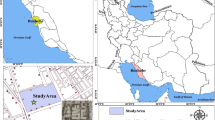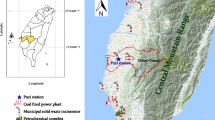Abstract
Chengdu, a megacity in southwestern China, experiences severe air pollution; however, knowledge of the seasonal variation in mass concentration, extent of potentially harmful elements (PHEs) contamination, and sources caused by heavy metals remains lacking. This study adopted a weighting method to calculate the daily mass concentration of PM1 and used ICP-MS to determine PHE concentrations. Results indicated that PM1 mass concentration was in the range 5.44–105.91 μg/m3. Seasonal PM1 mass concentration could be arranged in the following order: winter > fall > spring > summer. The concentrations of PHEs in the PM1 sample mostly showed the same seasonal variation characteristics as mass concentration. The average concentration of each PHE decreased as follows: Cu (107.44) > Zn (81.52) > Pb (22.04) > As (8.17) > Sb (1.91) > Ni (1.87) > Cr(VI) (0.84) > Cd (0.40) > Tl (0.33) (ng/m3). Enrichment factor values varied markedly from mild to anomalous enrichment. Principal component analysis revealed mainly derived from the fossil fuel combustion (55.215%).





Similar content being viewed by others
References
Agudelo-Castañeda DM, Teixeira EC, Schneider IL, Lara SR, Silva LFO (2017) Exposure to polycyclic aromatic hydrocarbons in atmospheric PM1.0 of urban environments: carcinogenic and mutagenic respiratory health risk by age groups. Environ Pollut 224:158–170
Belzile N, Chen Y-W (2017) Thallium in the environment: a critical review focused on natural waters, soils, sediments and airborne particles. Appl Geochem 84:218–243
Chakraborty A, Gupta T (2010) Chemical characterization and source apportionment of submicron (PM1) aerosol in Kanpur Region, India. Aerosol Air Qual Res 10(5):433–445
Chen M, Pi L, Luo Y, Geng M, Hu W, Li Z et al (2016) Grain size distribution and health risk assessment of metals in outdoor dust in Chengdu, Southwestern China. Arch Environ Contam Toxicol 70(3):534–543
Chen Y, Xie S, Luo B (2017) Seasonal variations of transport pathways and potential sources of PM2.5 in Chengdu, China (2012–2013). Front Environ Sci Eng 12(1):12
Chen G, Knibbs LD, Zhang W, Li S, Cao W, Guo J et al (2018) Estimating spatiotemporal distribution of PM1 concentrations in China with satellite remote sensing, meteorology, and land use information. Environ Pollut 233:1086–1094
Cheng X, Huang Y, Zhang SP, Ni SJ, Long ZJ (2018) Characteristics, sources, and health risk assessment of trace elements in PM10 at an urban site in Chengdu, Southwest China. Aerosol Air Qual Res 18(2):357–370
Dai QL, Bi XH, Wu JH, Zhang YF, Wang J, Xu H et al (2015) Characterization and source identification of heavy metals in ambient PM10 and PM2.5 in an integrated iron and steel industry zone compared with a background site. Aerosol Air Qual Res 15(3):875–887
Dall’Osto M, Booth MJ, Smith W, Fisher R, Harrison RM (2008) A study of the size distributions and the chemical characterization of airborne particles in the vicinity of a large integrated steelworks. Aerosol Sci Technol 42(12):981–991
Diapouli E, Manousakas M, Vratolis S, Vasilatou V, Maggos T, Saraga D et al (2017) Evolution of air pollution source contributions over one decade, derived by PM10 and PM2.5 source apportionment in two metropolitan urban areas in Greece. Atmos Environ 164:416–430
Du W, Yun X, Luo Z, Chen Y, Liu W, Sun Z et al (2020) Submicrometer PM1.0 exposure from household burning of solid fuels. Environ Sci Technol Lett [Internet] 7:1–6
Fan X, Lang J, Cheng S, Wang X, Lv Z (2018) Seasonal variation and source analysis for PM2.5, PM1 and their carbonaceous components in Beijing. Environ Sci 39(10):4431–4438 (in Chinese)
Galindo N, Yubero E, Nicolás JF, Varea M, Crespo J (2018) Characterization of metals in PM1 and PM10 and health risk evaluation at an urban site in the western Mediterranean. Chemosphere 201:243–250
Gope M, Masto RE, George J, Balachandran S (2018) Tracing source, distribution and health risk of potentially harmful elements (PHEs) in street dust of Durgapur, India. Ecotoxicol Environ Saf 154:280–293
Guttikunda SK, Goel R, Pant P (2014) Nature of air pollution, emission sources, and management in the Indian cities. Atmos Environ 95:501–510
Hu K, Guo Y, Hu D, Du R, Yang X, Zhong J et al (2018) Mortality burden attributable to PM1 in Zhejiang province, China. Environ Int 121:515–522
Huang Y, Wang L, Zhang SP, Zhang M, Wang JJ, Cheng X et al (2020) Source apportionment and health risk assessment of air pollution particles in eastern district of Chengdu. Environ Geochem Health. https://doi.org/10.1007/s10653-019-00495-0
Li HH, Chen LJ, Yu L, Guo ZB, Shan CQ, Lin JQ et al (2017) Pollution characteristics and risk assessment of human exposure to oral bioaccessibility of heavy metals via urban street dusts from different functional areas in Chengdu, China. Sci Total Environ 586:1076–1084
Lin H, Tao J, Du Y, Liu T, Qian Z, Tian L et al (2016) Particle size and chemical constituents of ambient particulate pollution associated with cardiovascular mortality in Guangzhou, China. Environ Pollut 208(Pt B):758–766
Liu L (2016) Physicochemical properties and source apportionment of urban ambient particulate matter in Dongguan and Wuhan. Huazhong Univ Sci Technol, PhD thesis (in Chinese)
Othman M, Latif MT, Mohamed AF (2016) The PM10 compositions, sources and health risks assessment in mechanically ventilated office buildings in an urban environment. Air Qual Atmos Health 9(6):597–612
Qin K, Zou J, Guo J, Lu M, Bilal M, Zhang K et al (2018) Estimating PM1 concentrations from MODIS over Yangtze River Delta of China during 2014–2017. Atmos Environ 195:149–158
Querol X, Alastuey A, Ruiz CR, Artiñano B, Hansson HC, Harrison RM et al (2004) Speciation and origin of PM10 and PM2.5 in selected European cities. Atmos Environ 38(38):6547–6555
Salcedo D, Castro T, Bernal JP, Almanza-Veloz V, Zavala M, González-Castillo E et al (2016) Using trace element content and lead isotopic composition to assess sources of PM in Tijuana, Mexico. Atmos Environ 132:171–178
Shen Z, Cao J, Arimoto R, Han Y, Zhu C, Tian J et al (2010) Chemical Characteristics of Fine Particles (PM1) from Xi’an, China. Aerosol Sci Technol 44(6):461–472
Singh DK, Gupta T (2016) Source apportionment and risk assessment of PM1 bound trace metals collected during foggy and non-foggy episodes at a representative site in the Indo-Gangetic plain. Sci Total Environ 550:80–94
Sternbeck J, Sjödin Å, Andréasson K (2002) Metal emissions from road traffic and the influence of resuspension—results from two tunnel studies. Atmos Environ 36(30):4735–4744
Tao J, Shen Z, Zhu C, Yue J, Cao J, Liu S et al (2012) Seasonal variations and chemical characteristics of sub-micrometer particles (PM1) in Guangzhou, China. Atmos Res 118:222–231
Tian M, Liu Y, Yang F, Zhang L, Peng C, Chen Y et al (2019) Increasing importance of nitrate formation for heavy aerosol pollution in two megacities in Sichuan Basin, southwest China. Environ Pollut 250:898–905
Wang H, Qiao B, Zhang L, Yang F, Jiang X (2018) Characteristics and sources of trace elements in PM2.5 in two megacities in Sichuan Basin of southwest China. Environ Pollut 242:1577–1586
Wang F, Wang J, Han M, Jia C, Zhou Y (2019) Heavy metal characteristics and health risk assessment of PM2.5 in students’ dormitories in a university in Nanjing, China. Build Environ 160:1–10
Wang J, Huang Y, Li T, He M, Cheng X, Su T et al (2020) Contamination, morphological status and sources of atmospheric dust in different land-using areas of a steel-industry city, China. Atmos Pollut Res 11(2):283–289
Yang H, Yang D, Ye Z, Zhang H, Ma X, Tang Z (2016) Characteristics of elements and potential ecological risk assessment of heavy metals in PM2.5 at the southwest suburb of Chengdu in spring. Environ Sci 37(12):4490–4503 (in Chinese)
Yang M, Chu C, Bloom MS, Li S, Chen G, Heinrich J et al (2018) Is smaller worse? New insights about associations of PM1 and respiratory health in children and adolescents. Environ Int 120:516–524
Yang BY, Guo Y, Bloom MS, Xiao X, Qian Z, Liu E et al (2019) Ambient PM1 air pollution, blood pressure, and hypertension: insights from the 33 communities Chinese Health Study. Environ Res 170:252–259
Yıldırım G, Tokalıoğlu Ş (2016) Heavy metal speciation in various grain sizes of industrially contaminated street dust using multivariate statistical analysis. Ecotoxicol Environ Saf 124:369–376
Zajusz-Zubek E, Radko T, Mainka A (2017) Fractionation of trace elements and human health risk of submicron particulate matter (PM1) collected in the surroundings of coking plants. Environ Monit Assess 189(8):389
Zhang Y, Lang J, Cheng S, Li S, Zhou Y, Chen D et al (2018) Chemical composition and sources of PM1 and PM2.5 in Beijing in autumn. Sci Total Environ 630:72–82
Zhu L, Liu Z, Chen B (2004) Geochemical background and element distribution in soil in Chengdu, Sichuan. Acta Geol Sichuan 24(3):159–164 (in Chinese)
Acknowledgements
This study was sponsored by the National Key Research and Development Project (2018YFC0214001, 2018YFC1508804), the National Natural Scientific Foundation of China (41977289) and the Beijing Environment Foundation for Young Talents (BEFYT).
Author information
Authors and Affiliations
Corresponding author
Additional information
Publisher's Note
Springer Nature remains neutral with regard to jurisdictional claims in published maps and institutional affiliations.
Electronic supplementary material
Below is the link to the electronic supplementary material.
Rights and permissions
About this article
Cite this article
Wang, J., Huang, Y., Li, T. et al. Annual Characteristics, Source Analysis of PM1-Bound Potentially Harmful Elements in the Eastern District of Chengdu, China. Arch Environ Contam Toxicol 79, 177–183 (2020). https://doi.org/10.1007/s00244-020-00751-w
Received:
Accepted:
Published:
Issue Date:
DOI: https://doi.org/10.1007/s00244-020-00751-w




